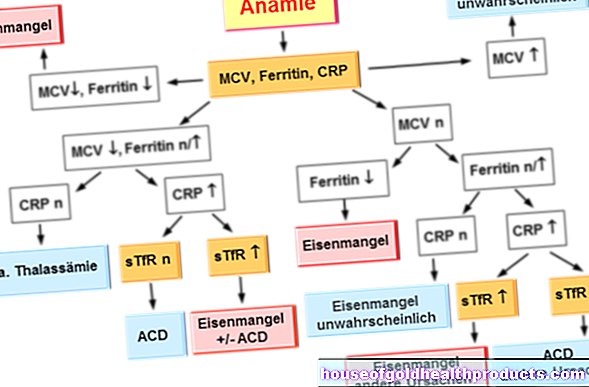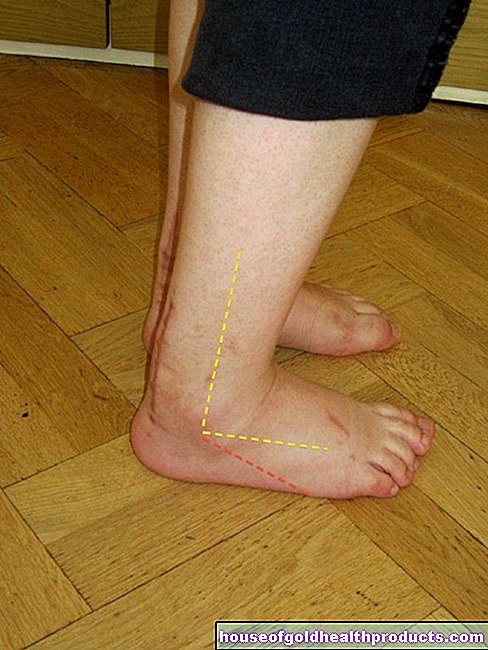Laminectomy
All content is checked by medical journalists.The laminectomy is a surgical procedure that provides relief in the event of a narrowing of the spinal canal. To do this, parts of the bony vertebral body are removed. If only half of the vertebral arch is removed, it is called a hemilaminectomy. Read everything about the procedure, the possible risks and how to behave after a laminectomy.

What is a laminectomy?
A laminectomy is a surgical procedure on the spine. The surgeon removes parts of the bony vertebral body in order to relieve constrictions (stenoses) of the vertebral canal.
When do you do a laminectomy?
Roughly speaking, the laminectomy serves to relieve the spinal canal. A common reason is spinal stenosis - narrowing of the spinal canal in which the spinal cord runs. Such stenoses can lead to pain or paralysis and thus represent a considerable burden for the patient. Spinal canal stenoses usually occur in the lumbar spine area. They can be caused, for example, by tumors or bony attachments.
Before the doctor recommends a laminectomy, however, he usually first tries to treat the patient with conservative measures, for example physiotherapy or painkillers. Often this can already alleviate the back pain. However, if there is not only pain, but paralysis or sensory disturbances, there is a suspicion of significant entrapment of the spinal cord or nerve roots. In such cases, a laminectomy should be performed promptly to save the nerves.
In the case of long spinal canal stenosis (a narrowing over a long area along the spine), the doctor sometimes has to remove parts of several vertebral bodies. This often makes the spine unstable. To prevent this, the laminectomy is combined with a vertebral block (spondylodesis) in such cases. The spinal column in question is stiffened with plates and screws.
What do you do with a laminectomy?
So that the patient does not feel any pain during the laminectomy, he is given general anesthesia for the procedure. The patient is then placed in the prone position so that the surgeon can access the spine. He then uses an X-ray to locate the exact location of the constriction and draws it on the skin with a felt pen. After a small incision in the skin, he exposes the spine by carefully loosening the muscles. The vertebral arch is now removed with small bone chisels or milling devices. If the constriction is only on one side, a hemilaminectomy is usually sufficient. Otherwise, the doctor will remove the entire vertebral arch including the ligaments.
Before the wound is closed, the surgeon places a drain in the operating area through which blood and wound fluid can drain. It is usually removed on the first or second day after the laminectomy.
What are the risks of a laminectomy?
Before the procedure, the doctor explains the risks of the laminectomy to the patient. These include injuries to nerve roots or the spinal cord that lead to paralysis or sensitivity disorders. These often recede, but in some cases they are permanent. If the spinal nerve roots at the end of the spinal cord (cauda equina) are injured during the procedure, problems with urination or bowel movements occur and sometimes sexual life is impaired.
Other risks of a laminectomy that the patient should be aware of include:
- CSF loss syndrome (leakage of nerve water)
- Connections of the nerve water space to the skin (liquor fistula)
- Infections and wound healing disorders
- Inflammation of the intervertebral disc and vertebral body (discitis or spondylodiscitis)
- Spinal instability
- chronic back pain, for example from scarred adhesions
- Renewed narrowing of the spinal canal (may make another operation necessary)
What should I watch out for after a laminectomy?
Interventions on the spine sometimes lead to a dysfunction of the bladder. Therefore, a urinary catheter will be placed before the operation. It is removed again in the first few days after the laminectomy.
After the laminectomy, you must not expose the spine to any improper stress. If you want to sit up after surgery, get help from a physical therapist, doctor, or nurse. You should also practice standing up properly with someone before you try it on your own for the first time. If a movement or position leads to pain or even paralysis and sensory disturbances, you should stop the movement immediately or move to another position. Avoid jerky movements!
After four to six weeks, you can usually move your spine back to normal. However, exposure is only allowed about three months after the laminectomy.
Tags: medicinal herbal home remedies hospital anatomy





























